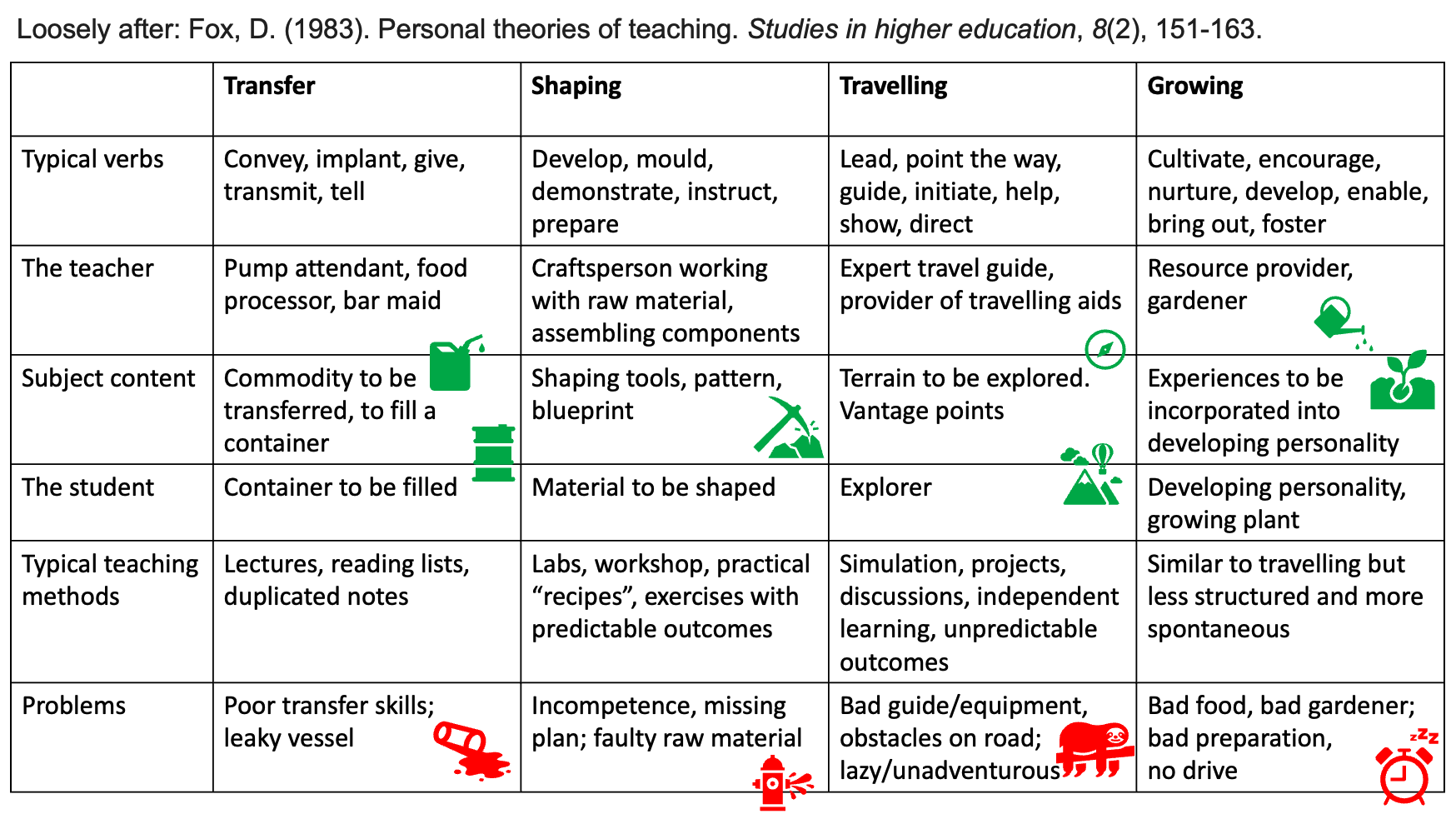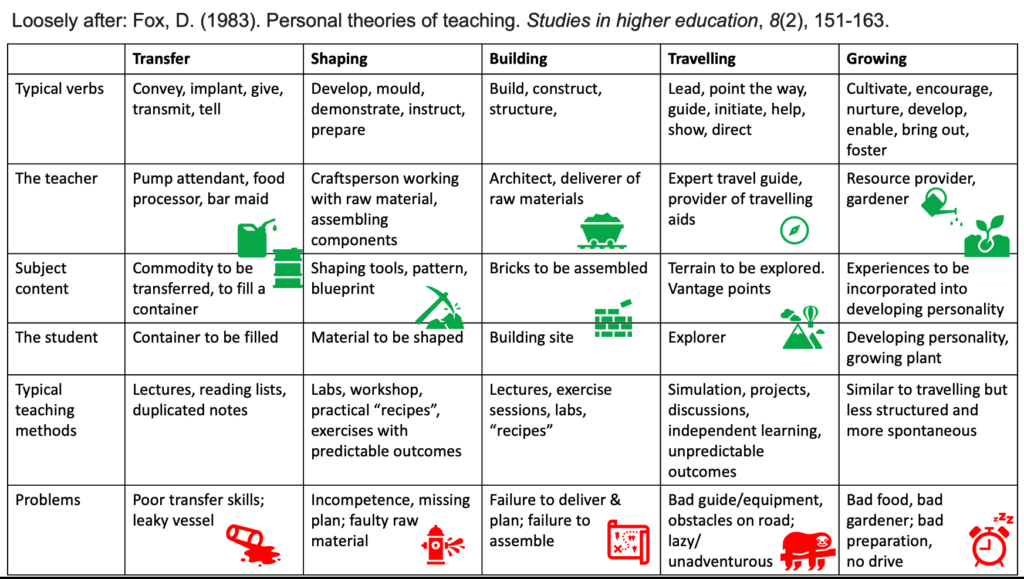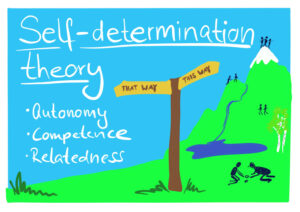
Teaching about “Personal theories of teaching” (Fox, 1983)
In preparation for next week’s course, I just read Fox (1983)’s “Personal theories of teaching” and decided that it’s worth some time and discussion. So here is what I am planning to do (right now, but plans might change until next Friday…):
Participants interview each other about what “What do you mean by teaching? What is actually happening?” (i.e. the original Fox question). And then, I pull up my table of Fox’s theories (see above, green icons illustrate the metaphors when things go well, red when things go wrong) and present the four main theories:
The Transfer Theory
In the transfer theory, there is some type of content that can be given from a teacher (the pump attendant, bar maid, or possibly food processor) to the student (a container to be filled). This happens for example through lectures, reading lists, or anything where knowledge can be “transferred”. If this goes wrong, that is commonly attributed either to poor transfer skills of the teacher (they aimed wrong) or by a leaky vessel that didn’t take up everything that was filled into it.
Variants of this theory are the content being
- prepared into bit-sized pieces of baby food that are easy to chew and digest, so complex ideas are simplified to make them accessible.
- broadcast into the world rather than aimed at a specific container. Hence it is not clear if anyone is actually listening and interested, if the information is relevant to anyone, how people might make sense of it. Kinda reminds me of how science communication is often done…
The Shaping Theory
In the shaping theory, we have a skilled craftsperson (the teacher) shaping the raw material (students) with the help of pattern or blueprints (the material). This happens for example through demonstration and instruction in labs, workshops, using practical “recipes”, and exercises with predictable outcomes. If something goes wrong, the craftsperson wasn’t as skilled, or the raw material was faulty.
Aspects I really like here are the checklists (I tend to write checklists as summaries of topics and use them on my slides and in my handouts, and I love it when authors really boil down their message, like for example Lang in Small Teaching) and practice opportunities!
A combination of the transfer and shaping theories that bridges over to the next two theories is the building theory, where an architect designs and delivers raw materials to a construction site, where bricks are put together. As I am not sure how closely I want to stick to the article (knowing myself maybe not too much), I also did the figure including this theory because I think I want to discuss the aspect of “but I brought everything to them, yet they did not put it together correctly!” (see below):
The Traveling Theory
In the traveling theory, students are explorers that discover the terrain of the subject matter with the help of an expert travel guide, who leads, points the way, initiates, shows in for example projects, discussions, and exercises with unpredictable outcomes. If this doesn’t work as well, it is attributed to a bad guide or bad equipment, unforeseen obstacles in the road, or lazy and unadventurous students.
I know that I have used this type of metaphors before, for example when talking about self-determination theory (e.g. here)
The Growing Theory
In the growing theory, the teacher gardens and provides nourishment to the developing personality and growing plant of the student. The student is cultivated, encouraged, helped through experiences that help them flower — similar types of experiences as in the traveling theory, but less structured and more spontaneous. If this doesn’t work, it is attributed to a bad gardener or the seedlings having no drive of their own.
This is the theory whose metaphors I have used most recently, for example in the proposal for Kjersti’s & my #CoCreatingGFI project
But I definitely relate to aspects of other theories, too, and I think I will follow Torgny’s suggestion and first draw myself into the table as an amoebae that wobbles between several of the theories, and then ask students to draw their interview partners where they would see them. Of course it is important to point out that there is no one “correct” theory, and that there are aspects of all that can be helpful depending on context! I think it’ll be fun, I’ll report back!
Any other ideas of what I could do with this?
Fox, D. (1983). Personal theories of teaching. Studies in higher education, 8(2), 151-163.



iEarth journal club on 'Education as Relational Process' by K. J. Gergen - Adventures in Oceanography and Teaching says:
[…] One quote that I find really helpful is that “the meaning of a word is its use in the language” — meanings of words change, a word can mean different things to different people, or even to the same person at different times, or depending on the tone it is spoken with. And also different depending on context: In the US, “how are you” does not require the same kind of response that I would tend to give to people just from hearing the question (as in — in the US it’s not even a question usually, then in some countries the appropriate answer might be “fine, and you?” and in others it would be an actual response to the question). And the way we talk about things is so important for how we actually think about them — see for example my post on “personal theories of teachers” (Fox, 1983). […]